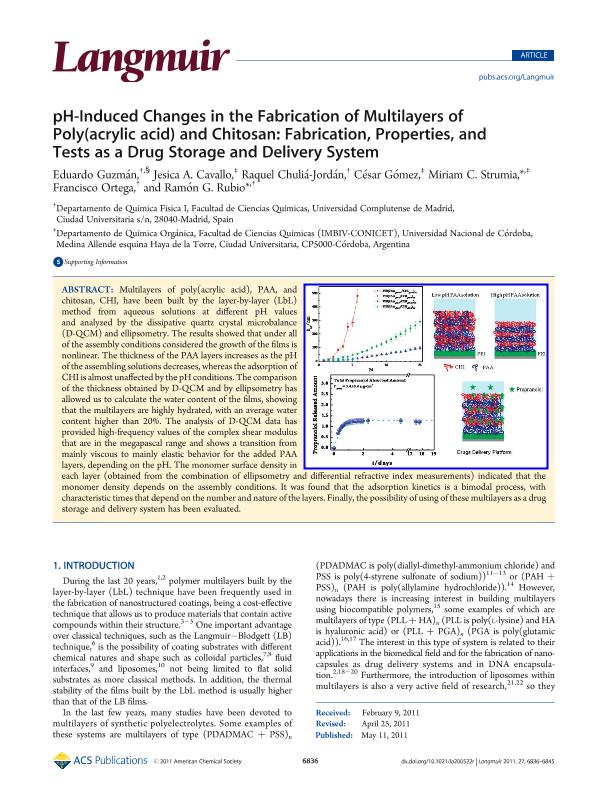Mostrar el registro sencillo del ítem
dc.contributor.author
Guzmán, Eduardo
dc.contributor.author
Cavallo, Jesica Anabel

dc.contributor.author
Chuliá Jordán, Raquel
dc.contributor.author
Gomez, Cesar Gerardo

dc.contributor.author
Strumia, Miriam Cristina

dc.contributor.author
Ortega, Francisco
dc.contributor.author
Rubio, Ramón G.

dc.date.available
2023-03-16T12:34:50Z
dc.date.issued
2011-06
dc.identifier.citation
Guzmán, Eduardo; Cavallo, Jesica Anabel; Chuliá Jordán, Raquel; Gomez, Cesar Gerardo; Strumia, Miriam Cristina; et al.; PH-induced changes in the fabrication of multilayers of poly(acrylic acid) and chitosan: Fabrication, properties, and tests as a drug storage and delivery system; American Chemical Society; Langmuir; 27; 11; 6-2011; 6836-6845
dc.identifier.issn
0743-7463
dc.identifier.uri
http://hdl.handle.net/11336/190736
dc.description.abstract
Multilayers of poly(acrylic acid), PAA, and chitosan, CHI, have been built by the layer-by-layer (LbL) method from aqueous solutions at different pH values and analyzed by the dissipative quartz crystal microbalance (D-QCM) and ellipsometry. The results showed that under all of the assembly conditions considered the growth of the films is nonlinear. The thickness of the PAA layers increases as the pH of the assembling solutions decreases, whereas the adsorption of CHI is almost unaffected by the pH conditions. The comparison of the thickness obtained by D-QCM and by ellipsometry has allowed us to calculate the water content of the films, showing that the multilayers are highly hydrated, with an average water content higher than 20%. The analysis of D-QCM data has provided high-frequency values of the complex shear modulus that are in the megapascal range and shows a transition from mainly viscous to mainly elastic behavior for the added PAA layers, depending on the pH. The monomer surface density in each layer (obtained from the combination of ellipsometry and differential refractive index measurements) indicated that the monomer density depends on the assembly conditions. It was found that the adsorption kinetics is a bimodal process, with characteristic times that depend on the number and nature of the layers. Finally, the possibility of using of these multilayers as a drug storage and delivery system has been evaluated.
dc.format
application/pdf
dc.language.iso
eng
dc.publisher
American Chemical Society

dc.rights
info:eu-repo/semantics/openAccess
dc.rights.uri
https://creativecommons.org/licenses/by-nc-sa/2.5/ar/
dc.subject
MULTICAPAS
dc.subject
POLIETILENIMINA
dc.subject
ACIDO POLIACRILICO
dc.subject
QUITOSANO
dc.subject.classification
Otras Ingeniería de los Materiales

dc.subject.classification
Ingeniería de los Materiales

dc.subject.classification
INGENIERÍAS Y TECNOLOGÍAS

dc.title
PH-induced changes in the fabrication of multilayers of poly(acrylic acid) and chitosan: Fabrication, properties, and tests as a drug storage and delivery system
dc.type
info:eu-repo/semantics/article
dc.type
info:ar-repo/semantics/artículo
dc.type
info:eu-repo/semantics/publishedVersion
dc.date.updated
2023-03-15T20:33:32Z
dc.journal.volume
27
dc.journal.number
11
dc.journal.pagination
6836-6845
dc.journal.pais
Estados Unidos

dc.description.fil
Fil: Guzmán, Eduardo. Universidad Complutense de Madrid. Facultad de Ciencias Químicas; España
dc.description.fil
Fil: Cavallo, Jesica Anabel. Universidad Nacional de Córdoba. Facultad de Ciencias Químicas. Departamento de Química Orgánica; Argentina. Consejo Nacional de Investigaciones Científicas y Técnicas. Centro Científico Tecnológico Conicet - Córdoba. Instituto Multidisciplinario de Biología Vegetal. Universidad Nacional de Córdoba. Facultad de Ciencias Exactas Físicas y Naturales. Instituto Multidisciplinario de Biología Vegetal; Argentina
dc.description.fil
Fil: Chuliá Jordán, Raquel. Universidad Complutense de Madrid. Facultad de Ciencias Químicas; España
dc.description.fil
Fil: Gomez, Cesar Gerardo. Consejo Nacional de Investigaciones Científicas y Técnicas. Centro Científico Tecnológico Conicet - Córdoba. Instituto Multidisciplinario de Biología Vegetal. Universidad Nacional de Córdoba. Facultad de Ciencias Exactas Físicas y Naturales. Instituto Multidisciplinario de Biología Vegetal; Argentina. Universidad Nacional de Córdoba. Facultad de Ciencias Químicas. Departamento de Química Orgánica; Argentina
dc.description.fil
Fil: Strumia, Miriam Cristina. Universidad Nacional de Córdoba. Facultad de Ciencias Químicas. Departamento de Química Orgánica; Argentina. Consejo Nacional de Investigaciones Científicas y Técnicas. Centro Científico Tecnológico Conicet - Córdoba. Instituto Multidisciplinario de Biología Vegetal. Universidad Nacional de Córdoba. Facultad de Ciencias Exactas Físicas y Naturales. Instituto Multidisciplinario de Biología Vegetal; Argentina
dc.description.fil
Fil: Ortega, Francisco. Universidad Complutense de Madrid. Facultad de Ciencias Químicas; España
dc.description.fil
Fil: Rubio, Ramón G.. Universidad Complutense de Madrid. Facultad de Ciencias Químicas; España
dc.journal.title
Langmuir

dc.relation.alternativeid
info:eu-repo/semantics/altIdentifier/url/https://pubs.acs.org/doi/10.1021/la200522r
dc.relation.alternativeid
info:eu-repo/semantics/altIdentifier/doi/http://dx.doi.org/10.1021/la200522r
Archivos asociados
